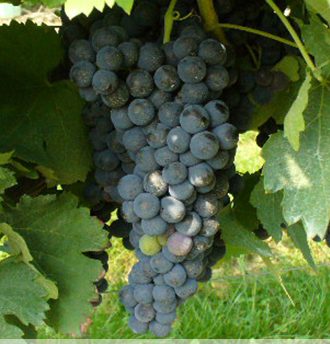Aglianico Grape
Black Grape

The Aglianico vine produces black berried grapes and is grown in the regions: Abruzzo, Basilicata, Calabria, Campania, Latium, Molise, Apulia, Sardinia, Sicily, Umbria.
Aglianico is a very ancient grape variety, as evidenced by the fact that its family over the centuries has divided into a large number of biotypes and sub-varieties. All this has created confusion with the proliferation of correct and incorrect synonyms for each biotype of Aglianico. Many different varieties were probably incorporated under the great cap of the historic “amine vines”.
Cato and Strabo already include at least three distinct varieties. Then Pliny and Columella further subdivide them into five or six types (Aminea, Aminea maior, Aminea minor, Aminea gemina maior, Aminea gemina minor, Aminea lanata). The first question therefore, which cannot be given a certain answer, is whether today’s Aglianico is one of the vines that made the wines of Campania Felix famous in ancient times, in particular those of Ager falernus (Falernum, Gauranum, Faustianum and Caecubum), and therefore whether it is somehow related to the Amineae.
Even if Pliny considers them autochthonous grapes for the long stay and the perfect acclimatization to the terroir of the coast and the hinterland of Campania, it is certain that they were imported by Greek colonists from Thessaly, perhaps from the Eubei, who in the eighth century BC they founded the Emporion of Pithekoussai (Ischia) and that of Kumei (Cuma). But even if we accept the hypothesis of Etruscan origin, we do not contest the distant Greek origin of the Amineae, since they can be traced back to a Pelasgic people, the Tessali Aminei.
Subsequently, with reference to Campania wines, Falerno has always been mentioned; even from the mid-sixteenth century the wording Aglianico appear for wines produced on Monte Somma.On the basis of this historical continuity and the analysis of the writings of Columella, which describes late ripening vines, as well as for linguistic reasons in the Aragonese period (between the end of the 15th and the beginning of the 16th century) there was the transition from Hellenic name to Aglianico, and this seems plausible if we consider that the double “ll” in Spanish is pronounced in a similar way to the Italian “gli” . Carlucci affirms at the beginning of the twentieth century that Aglianico is the grape of the mythical wines of antiquity.
However, it cannot be said that the numerous ampelographers of the 19th century managed to dispel the doubts that a grape variety so variable in phenological aspects and so rich in synonyms – Molon (1906) remembers more than thirty – could give rise. More recently, Murolo (1985) put forward the hypothesis of the assonance existing between Gauranico (ancient wine of Ager Falernus) and Glianico (dialectal denomination of Aglianico), while Guadagno (1997) rejects the Greek origin of Aglianico, arguing that its high acidity is typical of wild grapes. The hypothesis that the term Aglianico comes from the Latin Juliatico (or “grape that ripens in July”) is considered unreliable, because the vine ripens late and not early.
Characteristics of the wine
The grapes harvested in optimal conditions reach a high sugar content (22-23%) and retain a strong tartaric acidity, which is even higher in the Aglianico Amaro or Beneventano biotype; they also have an important tannic structure.
The wine obtained is suitable for long aging in wood which dilutes the robustness due to the acid-tannic component. The use of the barrique, a widespread practice in Campania and Basilicata, manages to tame the heat, making the wine softer and velvety in a short time.





